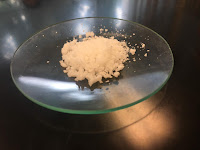Spherification which is the process of forming spheres of a liquid solution, was done to make yeast spheres using sodium alginate and calcium chloride. Two buffer solutions were made one included the yeast spheres and the other one had dry powdered yeast. Both of the buffer solutions were heated at 40 degrees while stirring at 200 rpms, we also placed an air pump to allow oxygen to flow into the solution in order to keep the yeast active and alive.
-Hadeel Darweesh
6/5/2019
Curcumin Sunscreen and Hand Cream
Friday, June 21, 2019
Formation of Methyl Stearate
Methyl stearate was formed to be used as an emulsifier for the cream. Stearic acid, methanol, and sulfuric acid were mixed and heated for 1 hour. The mixture was filtered and then washed three times with ice water and one time with acetone. A sample of Methyl stearate was placed in a test tube and ethyl acetate with 5% acetic acid was added which caused the methyl stearate to dissolve hence the methyl stearate is soluble.
-Hadeel Darweesh
5/27/2019
Tuesday, June 18, 2019
Difficulties in Determining Concentration
The new curcumin reaction taking place in the lab could possibly be very useful. However, HPLC has confirmed that the reaction produces a number of side products, which is not uncommon or unexpected. This means it will be impossible to determine the extinction coefficient of the new compound. The extinction coefficient is necessary to determine the concentration of this new compound in solution. UV spectra will have to serve only as a means of determining the maximum wavelength of the compound. Once an LCMS spectra is run, it will be easier to separate the major product of the reaction from the other side products.
-Alexandra Griffith
6/18/19
-Alexandra Griffith
6/18/19
Monday, June 17, 2019
Extraction of Dichloromethane
Dichloromethane Extraction Process
In order to isolate the curcumin from the turmeric powder, an extraction process was used where Methylene Chloride was the solvent and the turmeric powder was the solute.
Extraction Setup
Post extraction the product is filtered, then tested for it’s concentration.
- Hadassah Haricha
06.17.19
Tuesday, June 11, 2019
Argus Lab Testing
When the chemical structure of a molecule changes, it's maximum wavelength changes as well. This can be observed visually by a color change. That color change can be measured quantitatively using UV-Vis spectroscopy.
This week it was observed that when curcumin is reacted with yeast, there is a loss of color. This means that curcumin is undergoing a structural change. This structural change will eventually be identified using NMR. Before an NMR spectra is run, the chemical modeling software Argus Lab can be used comparatively with UV-Vis spectra to anticipate possible structural changes.
-Alexandra Griffith
6/11/19
Thursday, May 30, 2019
Different Ratios in Sunscreen
On Wednesday, 10 different sunscreens were made for future testing. Five had zinc oxide (ZnO) and the other five did not. Each group of five had consistently increasing amounts of curcumin. Increasing the amount of curcumin in the sunscreens meant also increasing the amount of alcohol in the sunscreen because the curcumin is kept in an ethanol solution as it is not water soluble. Increasing the amount of alcohol in the sunscreen meant that the more curcumin solution that was added, the more runny the resulting sunscreen would become. The results of the sunscreens initially did not show an exact pattern of increasing or decreasing viscosity, however once the sunscreens were left overnight, they all became more evenly viscous.
-Alexandra Griffith
5/30/19
-Alexandra Griffith
5/30/19
Thursday, May 23, 2019
Standardization of Turmeric
After refluxing the turmeric and ethanol, the solution was diluted and run through the ultraviolet spectrometer. The concentration of the solution was found to be 0.0113M curcumin. This information was then used to calculate the amount of curcumin in the powdered turmeric by mass.
The turmeric being used in the lab was confirmed to be 5% curcumin by mass.
-Alexandra Griffith
5/23/19
The turmeric being used in the lab was confirmed to be 5% curcumin by mass.
-Alexandra Griffith
5/23/19
Subscribe to:
Comments (Atom)





